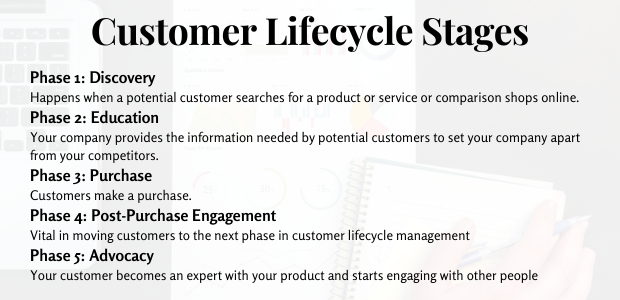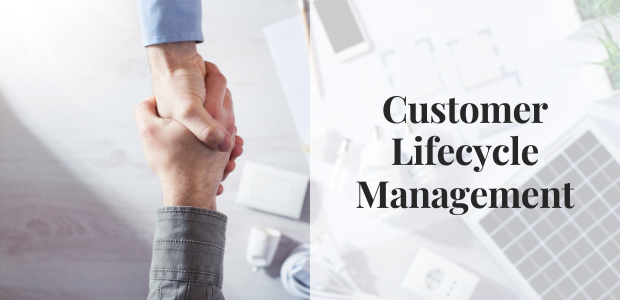SEO
Free SEO Analysis
SEO Services
Content Marketing Services
Local SEO
Link Building Services
Specialized SEO Services
PPC
REPUTATION MANAGEMENT
Free Reputation Management Analysis
Reputation Management Services
Review Management Services
Specialized Reputation Management Services
CEO Reputation Management
Brand Enhancement
Business and Directory Listings
Comprehensive Reputation Management Audit
SOCIAL MEDIA
Free Social Media Analysis
Specialized Social Services
WEB DEVELOPMENT
Free Website Analysis
Web Design Services
Mobile Development Services
Website Maintenance Services
Specialized Development Services
MARKETING AUTOMATION
Free Marketing Automation Analysis
Specialized Marketing Automation Services
Comprehensive Marketing Automation
INDUSTRIES
ABOUT DMA
Content Marketing
Your Ultimate Guide to Successful Customer Lifecycle Management
Request a quote
Its Fast, Easy & Free
Executive Summary
- Customer lifecycle management is important because it helps you nurture customer relationships, adding more value to your customers, and boosting brand loyalty.
- For each phase in the customer lifecycle, there are specific things you can do to ensure that the people entering your sales funnel make it through to the end.
- The best thing you can do to strengthen your customer lifecycle management process is to create quality content that pulls in the right kind of traffic to your site.
If you’ve put a lot of effort into creating just the right sales funnels only to find that potential customers are dropping out before making a purchase, customer lifecycle management is probably what you’re missing.
Just creating a sales funnel without putting anything else in place isn’t going to get you far.
In this article, you’ll learn what the customer lifecycle is and how to manage the customer lifecycle to move more of your site’s visitors from “just browsing” to brand advocates.
After reading, you’ll know what the customer lifecycle is, how to do customer lifecycle management, and what happens when potential customers don’t follow a linear flow through your sales process.
What Is the Customer Lifecycle?
The customer lifecycle is the series of steps customers take as they move through your marketing and sales funnels. The customer lifecycle follows the customer’s journey from pre-purchase through becoming a brand advocate.
According to Blake Morgan, the typical customer lifecycle follows these phases:

Phase 1: Discovery
Discovery occurs when a potential customer searches for a product or service or comparison shops online. Prior to Discovery, your potential customer may have no knowledge or limited knowledge of your business.
Phase 2: Education
In the Education phase of customer lifecycle management, your company provides the information needed by potential customers to set your company apart from your competitors. During this phase, you help potential customers find products and services that solve their pain points while showing them that your product is what they need.
Phase 3: Purchase
After educating your potential customers about how your product or service can solve their pain points, customers make a purchase. Hopefully, from you. The purchase and delivery should happen seamlessly.
Phase 4: Post-Purchase Engagement
Just because you made the sale doesn’t mean your work is done. Post-purchase engagement is vital to moving customers to the next phase in customer lifecycle management. Reach out to customers to find out if they’re satisfied with the transaction and their experience with your company. Your customer might surprise you with ways to make your product or services even better.
Phase 5: Advocacy
Advocacy should be the goal of every customer relationship. In this phase of customer lifecycle management, your customer becomes an expert with your product and starts engaging with other people about your company and products. This could take the form of social media posts, reviews, recommendations, ratings, how-to articles, and more.
It’s important to note that different customer lifecycle management experts will call these phases different names. For example:
Discovery > Approach > Reach
Education > Acquisition > Acquire
Purchase > Development > Nurture
Post-Purchase Engagement > Retention > Retain
Advocacy > Loyalty > Evangelize
Regardless of what the steps or phases are called, customer lifecycle management tends to focus on the same areas.
Why Is Customer Lifecycle Management Important?
Customer lifecycle management is important because it helps you nurture customer relationships, adding more value to your customers, and boosting brand loyalty.
Through customer lifecycle management, you have a much better chance of upselling or cross-selling than you do if you’re not actively working to nurture customer relationships.
This means that you can add value to your customers’ interactions with you while also leveraging that relationship to make more sales.
How to Do Customer Lifecycle Management

There’s a reason sales funnels exist. Since most customers follow a similar flow when it comes to finding the right product from the right company and making a purchase, it just makes sense to standardize the process to guide customers through it smoothly.
For each phase in the customer lifecycle, there are specific things you can do to ensure that the people entering your sales funnel make it through to the end.
Discovery
In this phase of customer lifecycle management, your potential customers may not know about you or how you can solve their pain points. Your goal is to make your target audience aware of your brand.
Find Your Target Audience

Who are you trying to reach? No matter how broadly appealing your product or service, you need to have a target audience in mind.
This doesn’t mean that you can only market your product to a single audience. When thinking about your target audience, you may come up with several different audience types.
That’s perfectly fine and normal.
For each target audience, we recommend creating a buyer persona that represents the target demographic and behaviors of that segment of your customer base.
This will help you create targeted marketing messages that resonate with each of your target audience segments.
Share Relevant Content
An enormous part of the Discovery phase of customer lifecycle management is drawing in the right audience for your product or service.
You’ll need to create useful, engaging content for your site and then optimize that content so you’re easily found in search engine results.
The type of content you create could be anything from regular blog posts to product pages to online courses—whatever appeals to your target audience.
Consider this an investment in your business. The more high-quality content you create and give away for free to potential customers, the more those potential customers will come to trust your company.
Then, when it’s time to make a purchase, your company will be the first that comes to mind.
Education
In the Education phase, you’ll help potential customers find products and services that solve their pain points while showing them that your product is what they need. Your goal in this phase of customer lifecycle management is to get potential customers to see your brand as a solution.
Provide Resources
Where sharing relevant content is more about pulling in the right kind of visitor to your website, providing resources is all about making potential customers’ lives easier.
People love being able to do their own research, so give potential customers all the information and resources they need to learn about your company and products so they can choose to buy from you with confidence.
We recommend creating a robust documentation section on your site where you share information about how to use your product and what sets it apart. And, you’ll definitely want to include an FAQ page.
Be Proactive With Customer Support

Your customer support team should be knowledgeable about your products and services, how everything works, and what it does.
Sometimes visitors aren’t going to be able to find the information that could push them to purchase your product because they’re not sure what it is they’re looking for.
In those cases, your customer support team can step in and answer any and all questions.
This goes beyond just waiting for a question to come in.
Your customer support team should be equipped to reach out to leads with trials and demos.
Purchase

The goal of the purchase stage is simple: get potential customers to buy your product.
Reduce Friction
By this stage of customer lifecycle management, your customer is ready to buy.
Make it easy for them!
Your checkout process should be smooth and fast. This means making it ridiculously easy to add products to the cart, enter contact information, and pay.
The easier you can make the checkout process, the fewer abandoned carts you’ll have to deal with.
Offer Support
It’s important to remember that the sales process belongs to everyone on your team. As such, customer support should be ready to jump in to address concerns shoppers have and help them make the decision to purchase.
We recommend adding a live chat service to your site so shoppers can easily contact a support person if they have questions during the purchase phase.
There are even live chat systems built specifically for eCommerce businesses that can notify a customer support agent when a shopper seems to be ready to abandon their cart.
Post-Purchase Engagement
In this stage of customer lifecycle management, your goal is to build up your image in the mind of your customers. They’ve already purchased; now it’s all about endearing your brand to them.
Personalize Your Post-Purchase Outreach
If you want to encourage repeat business (and why wouldn’t you?), you need to have a post-purchase outreach plan in place.
Fortunately, most email marketing services make it easy to set up email automation workflows so you can thank customers after their purchase.
We recommend creating a post-purchase email sequence that takes a few emails to thank your customer, ask for their feedback, offer them additional value, and try for an upsell or cross-sell.
Share Updates
When you release new products or features, let your customers know with an announcement on your blog and via email.
Drafting announcements can be tricky because you’re probably going to use them to sell to leads and to impress existing customers into either advocating for your brand or upgrading.
Keep your updates to the point, letting readers know what you have to offer right upfront. Then, show off the benefit this new product or feature provides.
End your update with a call to action that is specific to what you’re promoting. For example, you don’t want your call to action to be “subscribe to our email list” if you’re trying to sell an upgrade. A better call to action would be “be the first to access this new feature to get an edge over your competitors.”
Automate Your Marketing

Automation is vitally important for successful customer lifecycle management. Even if you have time to reach out personally and individually to each customer right now, you won’t forever.
It’s just not sustainable.
Marketing automation will help you scale your marketing efforts so you can nurture relationships no matter how large your customer base grows.
And, just because it’s automated doesn’t mean it can’t be personalized. Check out our guide to personalized marketing automation for how to do it.
Advocacy
Your goal in the advocacy stage is to get customers to share what they love about your brand.
Build Brand Advocates
The ultimate goal of customer lifecycle management is turning your customers into brand advocates. This involves keeping your customer happy.
But not just a little happy. We’re talking really happy.
To build brand advocates from customers, you need to make sure that every aspect of your process is on point. Customers aren’t going to go above and beyond for a company that doesn’t go above and beyond for them.
When you’re ready to ask an existing customer to advocate for your brand, make it really easy to do.
Specify exactly what you want them to do (leave a review, refer friends, etc.) and make it easy to do exactly that.
Offering a discount is a great way to get customers to advocate for your brand and it boosts your bottom line in two ways:
Your customer is driving additional potential customers to your company.
Offering a discount makes it easier for an existing customer to purchase from you again, increasing their customer lifetime value.
Non-Linear Customer Lifecycle Management
We’ve talked about customer lifecycle management as a series of steps or phases, but it’s also important to remember that customer lifecycle management is non-linear.
Potential customers can enter the customer lifecycle at any stage, revert back to an older stage, or even go through the same stage over and over again.
Because of this, it’s important to create educational, informative, and engaging content for all customer lifecycle management stages. This puts your company in a better position to capture potential customers no matter where they land in the customer lifecycle.
The customer journey is fluid and your customer lifecycle management strategy has to be agile.
Conclusion
Now you have everything you need for successful customer lifecycle management.
Remember, the best thing you can do to strengthen your customer lifecycle management process is to create quality content that pulls in the right kind of traffic to your site.
No time to produce the kind of content you need to bring in the right kind of leads? Let us do it for you! DMA is the best content marketing agency you’ll find. Our content marketing experts can create tailored content marketing that will drive the highest-quality leads possible.
Our Sales team